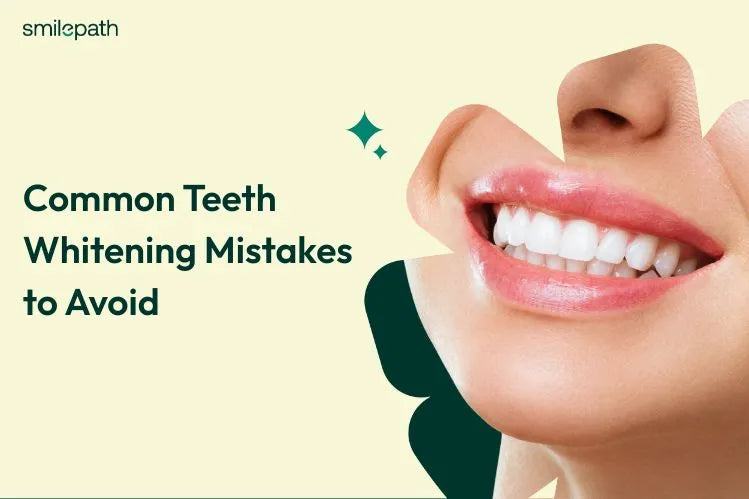
Table of Contents
- Skipping a Dental Checkup before Whitening
- Not Learning How to Whiten Teeth Safely
- Expecting Instant Results
- Overuse of Whitening Products
- Ignoring Tooth Sensitivity after Whitening
- Using Ill-Fitting Whitening Trays
- Using Lemon Juice or Apple Cider Vinegar
- DIY Teeth Whitening Dangers
- Effects of Incorrect Whitening Methods
- Teeth Whitening Mistakes, Risks, and Safer Alternatives
- Wrap-Up: The Smart Way to a Brighter Smile
- FAQs
Teeth whitening has become one of the most popular cosmetic dental procedures, thanks to its power to boost confidence by creating a brighter, more radiant smile. According to the Australian Dental Association (ADA), a 2021 consumer survey of 25,000 adults revealed that 22% of Australians have whitened their teeth, a rise from 14% since 2017.
However, improper methods or overuse can lead to serious teeth whitening side effects, including tooth sensitivity, gum irritation, and enamel erosion.
In this blog, we’ll uncover the most common teeth whitening mistakes, highlight key teeth bleaching risks, and offer practical tips on how to whiten teeth safely without harming your oral health.
Skipping a Dental Checkup before Whitening
A common yet risky mistake is beginning teeth whitening treatments without first consulting a dentist. Whitening products are best used on healthy teeth and gums. If you have untreated cavities, gum problems, or exposed tooth roots, bleaching can make these issues worse. Visiting your dentist first ensures your teeth are healthy and helps you select the safest, most effective whitening approach.
Not Learning How to Whiten Teeth Safely
Whether you’re using a store-bought whitening strip or a professional system, safety should be your priority. That means doing your homework, reading labels, following instructions, and checking with your dentist if you have doubts.
Good whitening habits also include strong oral hygiene: brushing twice a day, flossing regularly, and cutting down on stain-causing items like coffee, wine, and soda. Using fluoride toothpaste can strengthen enamel before and after whitening. And when in doubt, your dentist can help you pick the best whitening method for your individual needs.
Expecting Instant Results
Many people expect instant teeth whitening results from whitening products and get discouraged when they don’t see changes right away. This can lead them to overuse the product or opt for higher concentrations than recommended. Unfortunately, this increases the risk of tooth sensitivity, gum irritation, and enamel erosion, exactly the kind of issues dental professionals caution against.
Whitening is meant to be gradual. Stains—especially those from aging or medication- take time to break down. Trust the process, be consistent, and resist the temptation to overdo it in hopes of a quicker outcome. Rushing results can do more harm than good.
Overuse of Whitening Products
These products—such as whitening strips, gels, and trays—typically contain bleaching agents like hydrogen peroxide or carbamide peroxide. While these ingredients are effective at removing stains, using them too frequently or leaving them on longer than instructed can damage your enamel, the tooth’s natural protective barrier.
When enamel wears down, it not only dulls your smile but also increases the risk of teeth whitening side effects like lasting sensitivity, gum irritation, and a translucent or grayish tooth appearance. If you find yourself reaching for whitening products every few weeks, you could be causing more harm than good.
For teeth whitening safety, dentists recommend using these treatments no more than twice a year, unless directed otherwise by a professional. Always follow product instructions carefully, and when in doubt, consult your dentist for guidance tailored to your oral health needs. Your smile is worth protecting.
Ignoring Tooth Sensitivity after Whitening

Sensitivity after whitening is normal, but ignoring it is not. Whitening works by opening up the pores in your enamel so that bleaching agents can reach the dentin. This temporarily increases sensitivity to hot, cold, or acidic foods. Continuing to whiten while you're experiencing sensitivity may inflame nerves or cause long-term discomfort.
The risk gets worse if you use multiple whitening products together or don’t leave enough time between sessions. If sensitivity becomes severe, it’s best to stop whitening and consult your dentist. Switching to a toothpaste for sensitive teeth and avoiding extreme foods can also help relieve discomfort.
Using Ill-Fitting Whitening Trays
Store-bought, one-size-fits-all whitening trays might seem convenient, but they often don’t fit well and can cause issues. If the tray doesn’t fit your mouth properly, the whitening gel can leak out, irritating your gums and reducing the treatment’s effectiveness.
Leaked gel may also mean that some areas of your teeth don’t get whitened evenly. For better, safer results, dentists recommend using custom-fitted trays, even though they cost more, they’re tailored to your mouth and provide more consistent outcomes.
Whitening Toothpaste Damage
Another commonly overlooked issue is the frequent use of abrasive whitening toothpastes in daily routines. These often contain ingredients like baking soda or silica that scrub away surface stains. Used occasionally, they can be beneficial, but daily use can slowly erode the enamel.
Brushing too hard or using abrasive pastes too frequently can lead to receding gums, sensitivity, and dull-looking teeth. And because enamel doesn't grow back, it's essential to protect it. If you prefer whitening toothpaste, look for one with a low Relative Dentin Abrasivity (RDA) rating and limit use to a few times a week. A soft-bristled toothbrush and gentle brushing technique are your best bets for safe and effective results.
Using Lemon Juice or Apple Cider Vinegar
Trying to whiten your teeth with acidic substances like lemon juice or apple cider vinegar might seem like a natural option, but it can do more harm than good. These acidic liquids can erode your enamel, the protective outer layer of your teeth, making them more sensitive and prone to decay. The NHS warns that citrus fruits, such as lemons, are among the top foods known to damage your teeth.
DIY Teeth Whitening Dangers
Social media is full of DIY teeth whitening tricks that claim to offer quick and natural results. Be cautious; many of these so-called remedies are ineffective and even harmful. Popular methods such as brushing with baking soda and lemon juice, rinsing with pure hydrogen peroxide, or using activated charcoal can damage your teeth.
Lemon juice is acidic, and baking soda is abrasive, both of which can erode your enamel and harm your gums. As a result, your teeth become more vulnerable to discoloration and decay. Stick to products approved by dental organizations and avoid shortcuts that haven’t been scientifically tested.
Effects of Incorrect Whitening Methods
If you don’t follow proper whitening instructions or use unregulated treatments, such as those offered in some beauty salons, you risk several unpleasant side effects:
- Tooth Sensitivity: The inner layer of your teeth (dentine) can become extremely sensitive, causing pain and discomfort.
- Gum Irritation: If bleaching gel touches your gums for too long, it can lead to chemical burns or irritation. This might result in white or red patches that can take time to heal.
- Disappointing Results: Whitening your teeth improperly may give you uneven results. Over-whitening can turn your teeth gray instead of white, and if you have dental work like veneers or crowns, the bleaching agents won’t affect those materials, leading to mismatched shades.
Teeth Whitening Mistakes, Risks, and Safer Alternatives
| Mistake | Risk | Safe Alternative |
|---|---|---|
| Overuse of whitening products | Enamel loss, sensitivity | Follow instructions, space out treatment |
| Whitening toothpaste damage | Abrasion | Rotate with non-whitening fluoride toothpaste |
| DIY whitening methods | Acid damage, uneven damage | ADA-approved products |
| Ignoring oral health issues | Ineffective results, hidden decay | Pre-treatment dentist check |
| Skipping aftercare | Rapid discoloration | Sensitive teeth toothpaste, fluoride rinse, and avoid staining foods |
Wrap-Up: The Smart Way to a Brighter Smile

Teeth whitening can work wonders for your smile if done the right way. Knowing the possible side effects and understanding the risks involved with bleaching your teeth can help you avoid common mistakes. Overusing whitening products, relying on abrasive toothpaste, or trying unsafe DIY methods are just a few of the missteps people often make.
The good news is that with guidance from your dentist, the use of trusted products, a moderate approach, and proper aftercare, you can safely enjoy a bright, healthy smile that lasts. If you start to notice sensitivity or any other issues while whitening, don’t hesitate to check in with your dentist; they can give you advice that’s specifically suited to your oral health.
FAQs
Avoid overusing whitening products, using DIY methods like lemon juice or baking soda, brushing too hard, and consuming staining foods or drinks right after treatment.
Dentists may advise against whitening if you have cavities, gum disease, thin enamel, or existing sensitivity. Whitening can worsen these conditions or cause discomfort.
The safest method is using dentist-supervised whitening treatments or ADA-approved low-peroxide products paired with desensitizing toothpaste and proper aftercare.
Do: Follow product instructions, consult your dentist, maintain good oral hygiene, and avoid staining foods after whitening.
Don’t: Overuse products, mix multiple whitening methods, use abrasive toothpaste daily, or skip your dental checkups.
Citations:
American Dental Association (ADA). (2021). Tooth whitening/bleaching: Treatment considerations for dentists and their patients. https://www.ada.org/resources/research/science-and-research-institute/oral-health-topics/tooth-whitening
Greenwall, L. (2020). Tooth whitening techniques (3rd ed.). CRC Press.
https://doi.org/10.1201/9780429279044
Joiner, A. (2010). The bleaching of teeth: A review of the literature. Journal of Dentistry, 38(suppl 2), e17–e24. https://doi.org/10.1016/j.jdent.2010.07.002
Carey, C. M. (2014). Tooth whitening: What we now know. Journal of Evidence-Based Dental Practice, 14(Suppl), 70–76. https://doi.org/10.1016/j.jebdp.2014.02.006
Li, Y. (2011). Safety controversies in tooth bleaching. Dental Clinics of North America, 55(2), 255–263. https://doi.org/10.1016/j.cden.2010.12.001
Alqahtani, M. Q. (2014). Tooth-bleaching procedures and their controversial effects: A literature review. The Saudi Dental Journal, 26(2), 33–46. https://doi.org/10.1016/j.sdentj.2014.02.002
Greenwall-Cohen, J., Greenwall, L., & Barry, S. (2019). Safety issues when using peroxide-based whitening agents. British Dental Journal, 226(5), 345–349. https://doi.org/10.1038/s41415-019-0122-4







 Australia
Australia New Zealand
New Zealand Malaysia
Malaysia English
English Portuguese
Portuguese English
English English
English English
English English
English English
English Canada
Canada